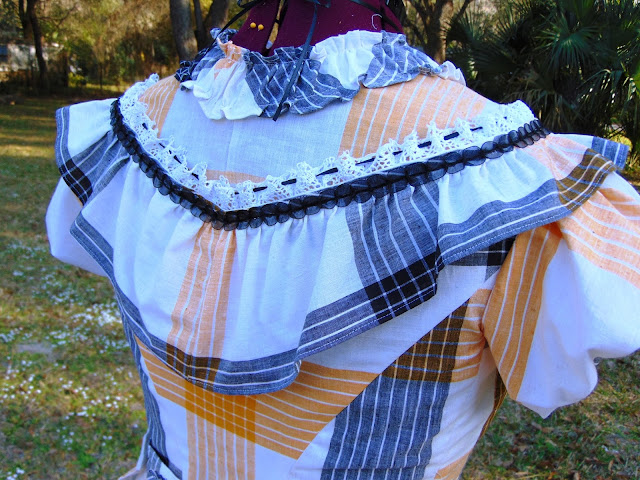Fabric: Lightweight 100% Cotton. Black, goldenrod, and white, all with a cross-weave of white (which has the effect of making the black look speckled and the goldenrod lighter in areas)
Measurements:
Chest: 42-44" (Padding and/or under-breast padding was common at this time)
Waist: 34"
Hip: <50"
Hem: 38" at front. 43" at back.
Available on Etsy HERE
~Features~This is an early 1870s day/evening dress suitable to the harsh summer heat. Contrary to the accepted norms of 19th century dress, ladies did wear short sleeves bodices in the summer heat, especially in the deep south and out West. This is backed up by extant pieces as well as some private photography from the era showing ladies in short sleeve dresses that were clearly not evening gowns.
This dress comes with a matching fichu that fills in the bodice and covers the shoulders for day wear, but is then removed to leave the shoulders and chest bare for evening wear.
~The Inspiration~
While I ended up going with an entirely different sort of fabric (I am currently on a no-fabric-buying diet) I did get the primary silhouette from this gorgeous existing museum piece. In the future, I plan to recreate this dress with a closer matching fabric.
I was also forced to make concessions due to lack of fabric. This dress, with all it's ruffles, looks like it would probably take about 11 yards or more. I consigned myself to working with only 8.5, for I was forced to leave off the flounces and most of the ruffles on the apron.
~Construction~
There was nothing particularly unique or difficult about the construction of this dress, so I did not take photos of the assembly process.
The bodice is a simple pattern consisting of front, side, side-back, and one back cut on the fold. The bodice ends at the nature waist, straight, but has a short cotton "skirt" on the bottom to assist with keeping it tucked in under the apron over-skirt.
(below) pictures of the short cotton skirt being attached to the bottom of the bodice.
The over-skirt is a standard apron design, though the front apron is flat rather than swagged at the sides, as you often saw in the early 1870s. Heavily swagged aprons came a bit later and were dominant in the 1880s, when you no longer see flat apron over-skirts at all.
The back portion of the skirt is lined in netting and has a drawstring channel about halfway down. When drawn closed it creates the puffed up shape.
The under-skirt has only one seam at the center back. It is a single panel, 126" wide. The hem is straight of grain, with all the height adjustments for the bustle and center front made at the waistband, not the hem. This method would sometimes be used with plaids or horizontal stripes in order to maintain the pattern at the hem level of the skirt. And, to be perfectly honest, I think it hangs better at the back this way. This was the method of making petticoats in the 18th century and I'm not sure why the Victorians did away with it and started making their height adjusts at the hem rather than the waistband, though I suppose it could because of the gored skirts.
~Finished~
*note the pictures that have the fichu covering the shoulders, and those that don't
(below) the fichu being worn outside the bodice. You can do it either way =)























No comments:
Post a Comment